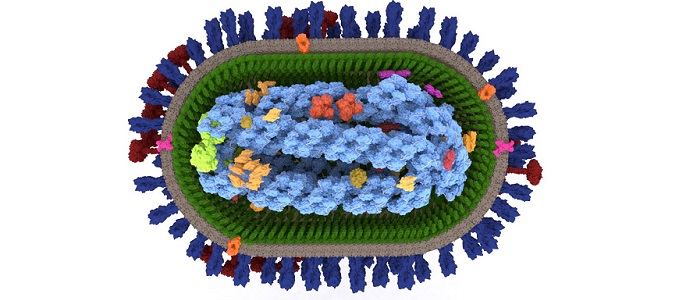iii research produces most detailed characterisation of influenza vaccine
Published: 15 November 2019
Research by the Institute of Infection, Immunity and Inflammation's Dr Edward Hutchison in collaboration with Astra Zeneca and published in Vaccine has used mass spectrometry to characterise the nasal flu vaccine used in schools across Scotland.

Research by the Institute of Infection, Immunity and Inflammation's Dr Edward Hutchinson in collaboration with AstraZeneca and published in Vaccine has used mass spectrometry to characterise the nasal spray flu vaccine used in schools across Scotland.
The approach shows exactly what is cleaned up at each stage in the purification process, and gives the most detailed picture of what remains in the intact virions used to make LAIV.
From a virologist's perspective, the research also discovered that the particular virus protein that controls the immune response turns up in some of the virions using the vaccine strains but not others.
Dr Hutchinson, a research fellow in the Institute's Centre for Virus Research (CVR), explained: "Looking at what went into influenza particles, we realised that utilising approaches used for characterising those particles in the lab could also be used to characterise the virus particles that were purified when making nasal spray vaccines.
"Because these vaccines are live attenuated - they take a harmless but still infectious virus and use that to trigger the immune response - they are purifying virus particles to make their product.
"We can look at all the stages in that process and, in very, very sensitive detail, figure out what's there and gets taken away as the virus is purified.
"These viruses are grown in chicken eggs, so there are a lot of non-virus materials to begin with. They have a purification process that cleans up the virus until, at the end, you have something that is so highly purified that even if you administer it to someone with an egg allergy it is still safe for them to take.
"Now for the first time we can really see, in a huge amount of detail, what's happening at each of those purification stages. It is a very flexible approach and one that will be useful to the vaccine manufacturer if they need to test variations in their method.
"The main reason for doing it was essentially one for technical interest for vaccine manufacturers. The wider interests are two-fold: one, is that from virologist's perspective it has shown us some new things about the virus.
"It showed us that the particular virus protein that controls the immune response turns up in some of the viruses used in the vaccine strains and not others - and that was new to us and quite surprising if you work on flu.
"Then, also, by dint of doing it, we have produced the most detailed description of what's found in the sort of material that is used in nasal spray vaccines we have in schools across Scotland, and, indeed, around the world.
"What's already known is that this material is safe to administer and the proteins present do not interfere with it being a safe or effective vaccine."
Read the full study here: Proteomics as a tool for live attenuated influenza vaccine characterisation
First published: 15 November 2019

